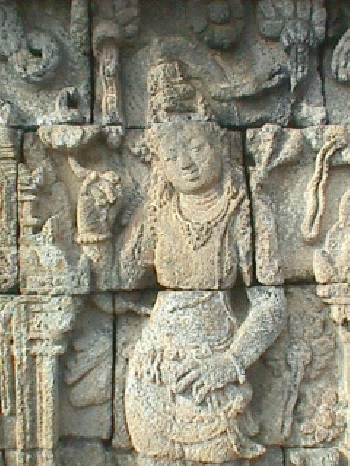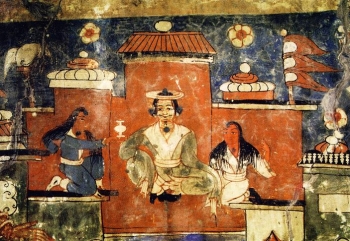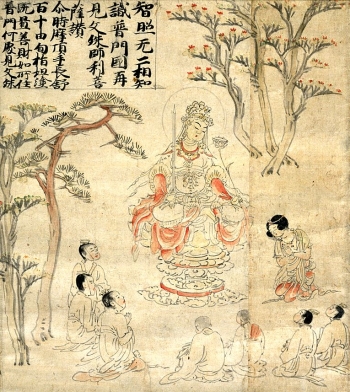“Turn the Wheel of Dharma in all the worlds for the benefit of all living beings, and in the manner congenial to potential converts.” – Kriy?sa?graha
I consider myself a fairly skeptical person in everyday life. I was a skeptical individual before my conversion and I remain so afterwards. Even now, I continue to read voraciously about diverse topics in Buddhist Studies that challenge many conventionally accepted things about Buddhism, from the early struggles of the Mah?y?na movement in India to postmodern Buddhist discourse in contemporary spheres. So it may be fair to say that beginners to Buddhist Studies are groomed to be skeptical. And that is a good thing, despite our sharing with many others a wish to fulfill a calling to a transcendent power.
The issue of revelation, or the self-disclosure of a higher power, was always a matter of concern to me. Like many presumptuous know-it-alls, I had several informal criteria that I like to think were at least somewhat measured, rational and careful. As such there were many religious texts, even Buddhist s?tras that did not quite convince me (one joke I share with my colleagues and friends is that the Pure Land of Amit?bha is an enlightened gentleman’s club since Bodhisattva Dharmak?ra vowed that no women will be reborn there). My criteria were as such:
1. There would have to be nothing morally repugnant in revelation, be it from a pantheon of divinities, a monotheistic God, or otherwise. A divine being worthy of worship would have to be a moral exemplar, the pinnacle of ethical perfection. Such a revelation would also have to accommodate humanity’s advancing values of social progress and justice, liberty and tolerance. I could never believe in a divinity that condoned or commanded genocide, any kind of sacrifice, the subjugation or oppression of women, attacks against non-believers, or superstitious ideas like witch hunting or eternal punishment.
2. A revelation would distinguishable from the folklore, political agendas, and superstitions that writers could have recorded in their historical context. There would be signs of inspiration that included an awareness of many worlds and universes, and not just the old three-tier universe of Heaven/Earth/Underworld. It would include a vast cosmos of multiple lives (the Presence gives many chances for salvation) and a trans-historical perspective (the vastness of outer space confirms our relative insignificance in the cosmos).
3. That it could withstand the Problem of Evil, of children (not to say other beings) in every corner of the globe being tortured, abused, and murdered aimlessly every day. Statistically a child dies every six minutes from the agony of starvation. That this could serve the purpose of a higher power is a hotly disputed idea in theodicy (the defence of God in the face of gross evil). I subscribe to the words of Dostoevsky’s Ivan: “Imagine that you are creating a fabric of human destiny with the object of making men happy in the end, giving them peace and rest at last, but that it was essential and inevitable to torture to death only one tiny creature — that baby beating its breast with its fist, for instance — and to found that edifice on its unavenged tears, would you consent to be the architect on those conditions? Tell me, and tell the truth.
Alyosha gives a noble reply, and the only reply possible for a person of conscience: “No, I wouldn't consent.”
4. Perhaps most importantly, a revelation that was true required a plan of salvation for non-human creatures (perhaps this criterion was propelled by my sadness after a bird that always came to our garden passed away in its favourite spot). Too many religions address only the human being and not the totality of sentience. Buddhism seemed to overcome this problem, but as I indicated above, despite the thorough moral training provided by the Mah?y?na path and the depth of the basic Buddhist philosophy, I was not persuaded by every text.
But there was one.
I first read the Avata?saka S?tra when I happened to chance upon Thomas Cleary’s English translation – the only one available on the market given its staggering vastness of over 1600 pages (and the fact that the Avata?saka canon incorporates two important, originally separate texts: the Da?abh?mika and Ga??avy?ha s?tras). I am no mystic, but the Avata?saka S?tra is a mystical text. Compiled in Central Asia, possibly Khotan, it was compiled to evoke lush, luminous visions of a bodhisattva’s eyes, her exalted viewpoint of reality. It is not so much a philosophical text (although it served, especially in Tang China, to lay the foundation for high Buddhist culture and philosophy) but a text to be reflected on, meditated, and absorbed. It was apparently the real first sermon by ??kyamuni, given to a celestial congregation of millions upon millions of divine beings. It speaks of the multiverse as an interconnected web of causes and conditions; a “Jewel Net of Indra” pervaded by the Buddha in every atom. So while it is true that everything is “empty,” everything is affirmed in this text as sacred and holy, for in the face of sa?s?ra is the face of the Blessed One.
Whatever the mysterious origins of this scripture (as with so many Mah?y?na texts), I was almost at once convinced of, and called to, its inspiration by a Presence of true compassion and love. It sings of, and envisages, infinite universes and divine planes, with bodhisattvas, goddesses, dragons, deities of sun and moon, saints, etc. serving countless Enlightened Ones throughout infinite aeons and performing inconceivable merit in the presence of the Buddha:
“I should earnestly cultivate practice in all worlds for the sake of sentient beings, attain an infinite free body pervading the cosmos, attain an infinite great mind pervading the cosmos, become endowed with infinite pure speech equal to the realms of the cosmos, appear in sites of enlightenment of infinite congregations throughout the extent of the cosmos, cultivate enlightening practices as infinite as the cosmos, realize equanimity of enlightening beings [bodhisattvas] as infinite as the cosmos, learn principles of enlightening beings as infinite as the cosmos, live by practices of enlightening beings as infinite as the cosmos, and enter into dedications of enlightening beings as infinite as the cosmos” (Ten Dedications: p. 673).
I am no Hua-Yen scholar, nor am I a competent exegete. Sometimes we can only let the text speak for itself and see how it holds up to the criteria of revelation that I set for myself. For me, the Avata?saka S?tra met and surpassed them. It remains one of the many (!) pinnacles of Buddhist morality, wisdom, and culture. It also demolishes many presumptions about Buddhist ideas. And in a sense, that is another thing that revelation should do – to cut away our commonly held, ego-bound assumptions about life, death, and what lies beyond.

















